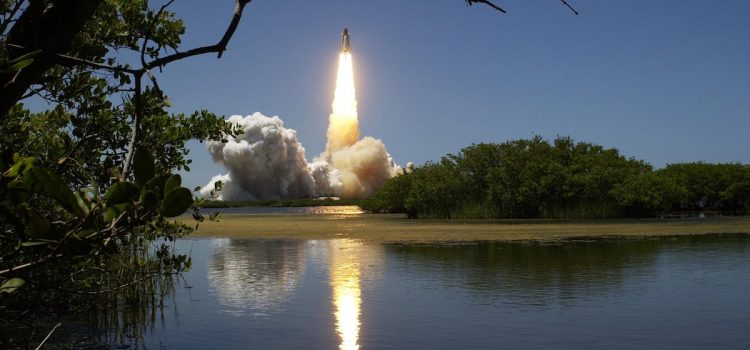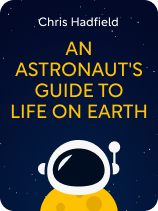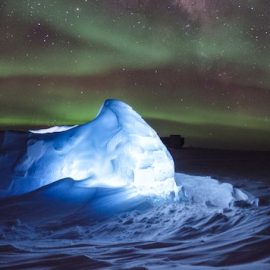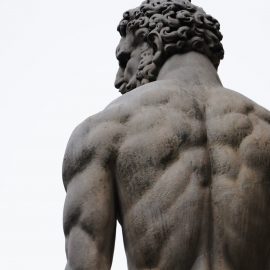

This article is an excerpt from the Shortform book guide to "An Astronaut's Guide to Life on Earth" by Chris Hadfield. Shortform has the world's best summaries and analyses of books you should be reading.
Like this article? Sign up for a free trial here.
How important were Chris Hadfield’s missions in space? What was his role in these space missions?
In An Astronaut’s Guide to Life on Earth, retired astronaut Chris Hadfield looks back on three space missions that changed his life and can change yours. These missions marked Hadfield as one of the most important astronauts in the Canadian Space Agency’s history.
Continue reading to learn the details of Chris Hadfield’s missions.
Hadfield’s Three Space Missions
Although Chris Hadfield technically became an astronaut the day he received his acceptance call from the CSA, he claims that he actually became an astronaut after years of rigorous, exciting training—training that taught him how astronauts think and behave. This was all before Chris Hadfield’s missions in space even took place.
(Shortform note: While Hadfield emphasizes the training he did after receiving his acceptance call, Canadian astronaut Dave Williams claims in his memoir, Defying Limits, that his astronaut training began before his own acceptance call. This training began when he was a kid: His childhood experiences exploring the woods, cooking over a fire, and tinkering with electronics taught him to work independently, pursue his curiosity, and learn from his failures. These skills prepared him for the joys and challenges of being an astronaut. For instance, Williams claims that the diving certification he earned as a teen prepared him to later start an underwater training program at NASA that trained astronauts for microgravity or weightlessness.)
Although most people assume that astronauts spend the majority of their time in space, Hadfield explains that in reality, astronauts spend most of their time on Earth, training to be in space. They study various subjects, run simulations to prepare for space travel, and support the missions of astronauts in space. Hadfield says that he loved this on-Earth training: He enjoyed learning new topics and contributing to every mission, not just his own space flights.
(Shortform note: There’s another reason why astronauts spend most of their job hours on Earth: Time in space takes a negative toll on their bodies. Therefore, they must limit their time in space. Beyond the protection of Earth’s atmosphere, they’re exposed to intense radiation from the sun, increasing their risk of cancer. Furthermore, when they’re in space, astronauts’ bodies grow accustomed to microgravity. They become used to moving around with no little resistance on their bones and muscles, and the fluids in their body (such as their blood and mucus) take time to calibrate. When they return to Earth, their bodies take a while to redistribute fluids and regain bone and muscle strength.)
Here, we’ll provide a brief overview of Chris Hadfield’s missions in space. All three flights involved working on space stations that orbit the earth, specifically Mir (The Russian Space Station) and the International Space Station (ISS). For Hadfield’s first two missions, the CSA—which worked with NASA—assigned him to fly on two NASA-operated Space Shuttle flights to Mir and the ISS, respectively. For his last mission, he served as commander of the ISS.
Mission 1: Attaching a Docking Module to Mir
For his first mission in 1995, Hadfield served as a mission specialist on the shuttle Atlantis bound for Mir. Mission specialists operate the systems on the space shuttle and space station, conduct experiments on the space station, and execute spacewalks (when you complete tasks while floating in space outside the shuttle and space station.)
For this launch of Atlantis, Hadfield and his four colleagues’ primary mission was to use the shuttle’s robotic arm, Canadarm, to install a docking module to Mir so that future flights could easily board the Russian station. The eight-day mission was successful, and Hadfield shares that he was proud of being the first Canadian to operate Canadarm.
(Shortform note: Hadfield’s first mission depended on collaboration between the Atlantis astronauts and the Russian cosmonauts on Mir. Collaboration between NASA astronauts and Russian cosmonauts continued for decades beyond this mission. However, due to the Russia-Ukraine War, this partnership has been put on hold. In mid-2022, Russia announced that in 2024 it would leave the ISS, which has historically been a site of US-Russian partnership. This announcement has left NASA astronauts scrambling to figure out how it’ll run the space station’s machinery and projects without the help of Russian cosmonauts and spacecraft.)
Mission 2: Installing a New Robotic Arm on the ISS
Endeavour set off for the International Space Station in 2001, carrying Hadfield, six other astronauts, and Canadarm2 (a new robotic arm). Hadfield once again served as a mission specialist, and the crew’s 11-day mission was to install Canadarm2 at the ISS so future astronauts could use it for repairs and projects.
(Shortform note: Astronauts continue to use Canadarm2 on the ISS, and it’ll remain a robotic arm on the ISS until around 2030 when the space station will be decommissioned. Additionally, the next version of the robotic arm—Canadarm3—is on its way: According to NASA’s plans, this robotic arm will service the Lunar Gateway, an ISS-like outpost scheduled to begin orbiting the Moon in 2024.)
Hadfield completed his first spacewalks during this mission into space—but one of them didn’t go quite according to plan. During this spacewalk, Hadfield’s eyes suddenly became irritated. Due to the lack of gravity, his tears accumulated in his eyes instead of falling, and he was unable to see for a large portion of the spacewalk. He later learned that the anti-fog solution he’d used to clean his helmet had irritated his eyes. Despite this hiccup, the mission was a success, and Hadfield was thrilled to be the first Canadian to perform a spacewalk.
(Shortform note: In a talk he gave in 2014, Hadfield claimed that this experience informed his belief that you can program yourself to be fearless. Temporarily blindness in space would make most people panic—but Hadfield said that he didn’t panic, thanks to countless hours of on-Earth training that simulated worst-case scenarios in space. According to Hadfield, this training was like requiring someone with arachnophobia to walk through hundreds of spiderwebs until they no longer feared spiders. This approach to managing fear resembles exposure therapy, a therapeutic approach that helps people with anxiety disorders overcome their fears and phobias by exposing them to increasingly frightening situations over time.)
Mission 3: Commanding the ISS—and Making Music Videos
For Hadfield’s final mission into space in 2012, he served as Commander, making him the first Canadian to command the ISS. The Soyuz spacecraft launched Hadfield and his five crewmates on a mission to deliver supplies to the station and conduct several science experiments. The purpose of these experiments was to learn about the effects of microgravity on humans and other living things.
(Shortform note: Today, astronauts aboard the ISS continue conducting experiments to learn about how humans and other life forms manage in space. For instance, in 2022, astronauts collected data for an experiment examining how bones heal in microgravity. Researchers are hopeful that the experiment could influence bone therapies for people who suffer from bone loss due to osteoporosis.)
Besides being the first Canadian to command the ISS, Hadfield was also the first astronaut to record a music video in space. During this third mission, he performed a rendition of David Bowie’s “Space Oddity,” complete with space-related lyrics, shots of him and his guitar floating in microgravity, and scenes of Earth rotating outside the station’s windows. Hadfield’s goal in recording the video was to open viewers’ eyes to the wonders of space flight and the beauty of Earth. The video amassed over 50 million views.
| Canadian Media Coverage and Praise of Hadfield’s “Firsts” In describing his three space flights, Hadfield shares his pride in his many “firsts”—being the first Canadian to operate the Canadarm, perform a spacewalk, serve as Commander on the ISS, and film a music video in microgravity. What did these “firsts” mean for Canadians? Hadfield’s first mission: A Canadian museum’s celebration of Hadfield’s first mission and the Canadarm suggests that this mission is a proud moment in Canadian history. In 2013, the Canada Aviation and Space Museum unveiled an exhibit that features the retired Canadarm. For the exhibit’s opening night, Hadfield was invited via video broadcast from space to introduce the robotic arm. A Canadian government official who spoke at the unveiling called the Canadarm’s 1995 installation “one of Canada’s greatest achievements in the space industry.” Hadfield’s second mission: In 2001, The Calgary Herald ran a front-page article about Hadfield’s second mission, which suggests that the mission inspired pride among Canadians. The issue features a large image of Hadfield suspended in space, dwarfed by the gleaming white body of the ISS. The headline reads, “Hadfield takes one giant step for Canada”—a reference to Neil Armstrong’s statement that the 1969 moon landing was “one giant leap for mankind.” Hadfield’s third mission: Political figures’ commentary about Hadfield’s role as the first Canadian commander of the ISS suggests that his achievements on his third mission were significant for Canadians. Both Queen Elizabeth II and Canadian Prime Minister Stephen Harper congratulated Hadfield on becoming Commander. Harper called Hadfield’s accomplishments in space “a tremendous source of national pride.” Lastly, reactions to Hadfield’s “Space Oddity” music video reveal that praise for his achievements extended beyond the borders of Canada. The video garnered worldwide attention and acclaim. David Bowie himself praised the rendition of his song, calling it “possibly the most poignant version of the song ever created.” |

———End of Preview———
Like what you just read? Read the rest of the world's best book summary and analysis of Chris Hadfield's "An Astronaut's Guide to Life on Earth" at Shortform.
Here's what you'll find in our full An Astronaut's Guide to Life on Earth summary:
- Chris Hadfield's experience of becoming an astronaut
- The five life lessons Hadfield learned in his role as an astronaut
- Why you should find joy in everyday life rather than looking forward to milestones






